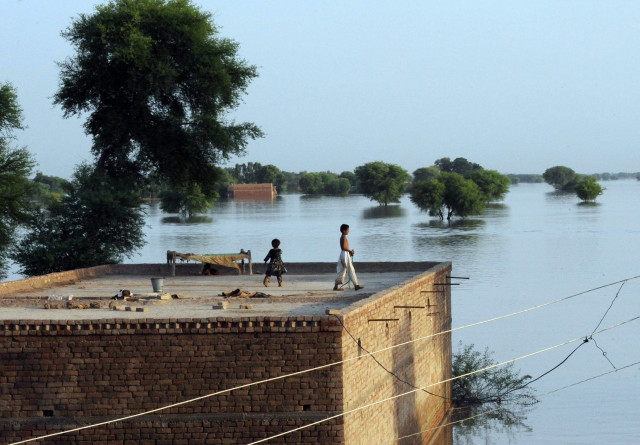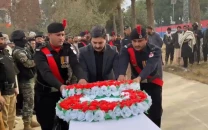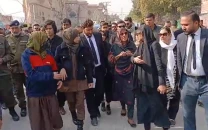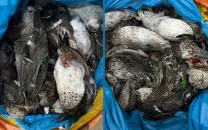Sight of tree-tops signals residents that it’s time to go back
Residents of the kachcha areas of Sukkur have taken the hint and have started preparing for their return.

Sight of tree-tops signals residents that it’s time to go back
Residents of the kachcha areas of Sukkur have taken the hint and have started preparing for their return. Since most of them lost almost all their belongings, many are collecting rations from the drier areas so that it lasts them when they go home.
One such family is residing at the Bachao bund and are waiting for their land to resurface. This family has started drying and sorting wheat grains so that they can grind it into flour before they head home.
“There will be a lot of mud in the area so that will be a problem,” explained the head of the family. “We need medicines for not only ourselves but also our animals,” he said, requesting the government to help them out.
A large number of animals are suffering from various diseases and need to be treated before they can become productive. This family is hoping to return in a day or two.
There are several such families who are tired of living at the relief camps where they struggle to find food and shelter.
“We do not have a house anymore and we lost all our valuables and livestock in the floods,” complained a resident. “We are not getting anything to eat either and no one from the government has bothered to inquire about us,” he added, fearing for the health of his children.
Meanwhile, some residents are hoping to go back as soon as they can. “The water has come down from where it was but even after it recedes, there will still be mud in the area,” said another resident. “It will take us at least a week before the conditions are fit for our return,” he added, happy that his animals and children are all safe with him.
Town residents also headed home
Several people belonging to the pacca areas of districts Ghotki, Jacobabad and Kashmore have started to move back towards their homes. When the floods hit these districts, some of these people chose to stay at relief camps while others set up their huts on the embankments. The Indus River is now running on low-flood mode, hence, residents of towns have decided that it is safer to move back.
Some criminals in Ghotki, who used to live in the forests of kachcha areas, were forced to evacuate their hideouts but they refused to shift to relief camps. Out of fear of getting caught, they chose to live on the embankments instead. Now that the water has started receding, they have moved back to their safe havens. Residents of the kachcha areas of Ghotki are, however, still reluctant to move back and are waiting for the water to go back completely.
During a survey of some relief camps, residents of Ghouspur and Karampur told The Express Tribune that there is nothing left for them in their villages. They want the government to allot them land in the outskirts of Sukkur so that they can start a new living.
Reports from Kashmore also revealed that the survivors are contemplating returning to Kandhkot, Tangwani and Badani towns. When Tori and Ghouspur embankments developed breaches, more than half of the population of Kandhkot, Tangwani and Badani had fled and taken shelter in relief camps or at the embankments.
Similarly, residents of Thal town in district Jacobabad are now returning home. Very few people relocated from Sukkur but residents of Ghulam embankment had fled from their homes and are now headed home.
Additional reporting by Sarfaraz Memon
Published in The Express Tribune, August 25th, 2010.



















COMMENTS
Comments are moderated and generally will be posted if they are on-topic and not abusive.
For more information, please see our Comments FAQ